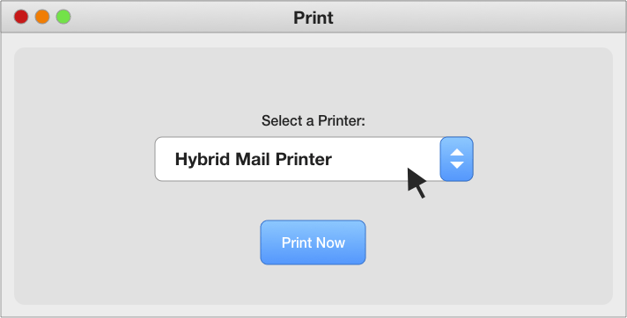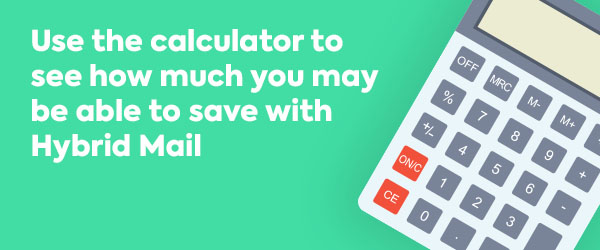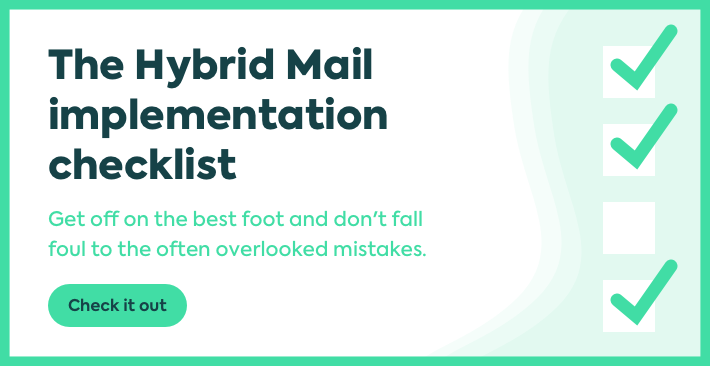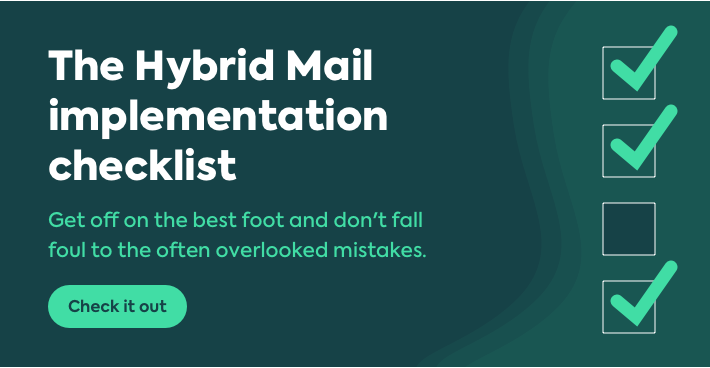If you’re thinking about using a Hybrid Mail solution, we have designed this guide to arm you with all the information you need to decide which type of solution you require.
There are many solutions available to you, including ours but there is a broad variation between them.
To help you make an informed decision, this guide will cover everything you need to know when considering which solution is best for you - and we’ve been cautious to be as impartial as possible.
We’ll be dispelling some of the common misconceptions, covering off the common jargon and exploring the different types of solutions and vendors available to you today in this expanding market.
You’ll also be able to calculate how much you could potentially save with a Hybrid Mail system and get a clear understanding of implementation costs and timelines.
If you’ve already made your mind up that this solution is for you - download our Hybrid Mail implementation checklist to make sure you’re getting off on the best foot (even if it's not with us).
Don't fall foul to the often overlooked mistakes.
CONTENTS:
What is Hybrid Mail?
How does it work?
What kind of documents can you send?
Who uses Hybrid Mail (and is it right for us?)
How much does it cost to implement and are there ongoing costs?
Exploring the different vendor types
Where does Hybrid Mail fit into your CCM strategy?
Hybrid mail (sometimes called print and post) enables you to send physical mail (e.g. invoices, statements, letters, advertising, direct mail, customer comms etc.) directly from your desktop or laptop computer, no matter where you or your team are located.
Not in the office? Pretty common now; no problem.
 You currently have to create your document, print it on your office printer, collect it, fold it, gather up additional inserts and then stuff an envelope.
You currently have to create your document, print it on your office printer, collect it, fold it, gather up additional inserts and then stuff an envelope.
Then you have to print or write an envelope, put a stamp on it, post it yourself, or send it to your internal mailroom for franking and posting.
With a hybrid mail system, the majority of this is handled for you externally.
You still write your document and then ‘print’ it but instead of the document being printed on your office printer (or your employees own printer), it is printed off-site at a specialist location.
Someone else encloses it in an envelope and posts it without you even needing to get up from your chair (or move from your standing desk!).
 You could think about it as a fire and forget ‘click-print-and-it’s-done’ service.
You could think about it as a fire and forget ‘click-print-and-it’s-done’ service.
What’s more, some systems can be tailored to your precise requirements.
So, for example, if you regularly send out packs of information that contain more than just a letter but include printed inserts and a business return envelope, too, you could have your system set up to do just that too.
So, in summary, it is a system that enables you and your team to print, enclose and post documents or packs of documents from the comfort of your desk, in only a few clicks of your mouse.
No more faffing with packing and posting. No more getting frustrated at the office printer. No more wasted time.
 Sound good?
Sound good?
Well, it’s even better than that. It’s almost certainly going to cost less to than to do it manually like you are now.
We’ll get to that a little later in this guide, where you can calculate potential cost savings.
If you can't wait to get there, jump straight to the savings calculator.
On the face of it, it seems very simple but there are quite a few moving parts that need to be set up correctly for you to get the most out of it - and maximise your savings.
At your end, there is a printer driver installed onto your computer that enables you to ‘print’ to your hybrid mail system.
There are also document templates that you can pick from when writing your documents. For example, you might want to write a contract renewal notice or an appointment reminder. Of course, both would require a different document template but this would be set up for you before you get started.
At the receiving end, a third party picks up the print request, pairs it with the print request specifications, such as envelope type, postage tariff, and required inserts, and then prints the document.
Once printed, your documents are paired with their inserts, if required and enclosed into envelopes and posted.
You prepare - we print - we post.
This also unlocks several other benefits such as increased compliance, improved brand control, consistency of output, enhanced MI and postage optimisation to deliver significant savings - all of which we will look at later in this guide.
So many different types!
From appointment letters to insurance renewals invoices, internal comms, interest rate change letters etc.
Here are some sector-specific examples to give you an idea of where the system fits into the overall customer communication and customer experience ecosystem.
In the retail finance sector you could send:
Read our article on How Hybrid Mail is Transforming Operations in Financial Services.
In truth, there are so many benefits but the core benefits can be categorised into six key areas:
Hybrid Mail will almost certainly save you money.
 By consolidating production runs, instead of manually handling a random quantity of documents and numerous times internally, you can take advantage of the cost savings that come with operational efficiencies.
By consolidating production runs, instead of manually handling a random quantity of documents and numerous times internally, you can take advantage of the cost savings that come with operational efficiencies.
Some organisations (the most prominent vendors) can offer postal optimisation, which means you get to take advantage of their favourable postage rates, which they receive from sending higher volumes of post than you ever will alone.
On top of that, you can also benefit from eliminating the need to produce, store, and replenish base stationery. No more buying and storing reams of pre-printed document templates. No more hassle from distributing said documents around your team and no waste from printing documents on the incorrect template.
Oh and you can feel good about only printing what you need, so you’re saving paper, trees, electricity. So basically, you have a better carbon footprint, which is more than just nice to have these days, especially if you have a CSR policy.
Let your team focus on core, day-to-day objectives.
The ones that help you drive results.
Rather than have them spend time getting frustrated with the printer, stuffing envelopes and running marathons around your site to deliver documents into the next pair of hands that need to handle them before they can finally get out of the building and into the hands of your customers.
On average, a good system will save 3-5 minutes of staff time per document. If you send ten documents a day, that’s nearly an hour a day.
That’s about 22 days a year of lost time.

This is often a hidden cost to businesses and we’ve included it in our Hybrid Mail savings calculator. We call it a burden cost. If you’d like to see what your actual burden cost is, talk to a member of our team and we’ll work it out together.
You can often do more for less. For example, your office printer will only do so much. A good one will do multiple paper sizes and if it has lots of paper trays, you could load them with different templates too.
Although do consider that you’ll have to store all of the different pre-printed templates somewhere and distribute them to your remote team. And there will be issues when some of your team forget to inform you that they’re running low and suddenly run out.
But you’ll still have to keep those paper trays topped up (for every printer in the building) and you’ll probably still have to print the envelopes and stuff them by hand.
A well-configured system can be customised to meet your various requirements.
You’ll likely get full colour, duplex, A4 print as standard, with the option to choose envelope size, postage tariff, branded stationery, onserts, inserts, and attachments.
If worrying about your carbon footprint is on your radar right now, consider that this system reduces waste as everything is printed on demand.
No more stockholding of all your different doctypes - or ever running out!
Some suppliers offer 100% recyclable, biodegradable envelopes at no extra cost but be sure to check with your supplier as not everyone provides this and for some, it’s an added extra.
Submit documents using a print driver, eliminating the need to login to a website, with the option to enable Single Sign-On (SS-O).
It’s as simple as that.
Once your platform is set up, using it is as simple as printing a letter. All the magic then happens behind the scenes and you can get on with more important jobs.
And it’s a high-availability service too, so you’ll benefit from improved business continuity as it’s online 24/7/365.
Need to send out an urgent letter but it’s 11 pm and you’re at home? No problem. Send it to print and it’ll join the next print run and be sent out the next day.
It's so much easier for you and your team to create and dispatch communications that strictly adhere to brand guidelines.
It’s not uncommon for ad-hoc communications to stray from brand guidelines and best practices and that’s terrible for brand reputation.
Human errors can happen too.
It’s also worth noting that the time to deliver ROI is incredibly fast.
Setup and launch could happen in as little as 14 days (with the key players ready and available) and you’ll start to benefit from the cost savings from the day you start using it.
What are the drawbacks?
In reality, it’s all upside. If you meet a basic threshold (you can calculate that here) then you and your whole team will benefit from a properly setup system.
The only thing to consider is that you’ll be reliant on a third party to print, enclose and post your mail, so make sure you pick a reputable vendor.
Finally, some systems rely on access to a web portal in order to create your customer comms. We’ve seen some pretty clunky ones that would drive anyone mad on a day to day basis. Make sure to get a demo!
When picking a vendor, remember to ask them for their industry accreditations, case studies and check what is happening in-house vs being outsourced.
Usage is rapidly growing. It’s not a new idea and most companies that send out a reasonable volume of ad-hoc mail, eventually realise the benefits and make the switch.
As you can imagine, the pandemic has been a trigger for many companies to move to a different way of working, where they have the need for their remote team members to simply upload a file and be confident that it’ll be printed, enclosed and posted the next day.
Hybrid mail is used in a wide range of industries that all share two common problems - they want to reduce their postage costs and make the creation and delivery of ad-hoc branded comms easier and more efficient.
Is it suitable for you? Ask yourself these questions:
If the answer is yes to all three, you’re very likely to be a perfect fit.
Read our article on How to Build a Business Case for Hybrid Mail.
If you answered yes to all three questions above, then yes, it’s incredibly likely that you can save money.
But how much?
If you’re sending a high volume of post, then there could be significant savings to be made.
Let’s look at some numbers. Here’s an example of in-house costs vs using a Hybrid Mail system.
| Item | In-house unit cost |
| Pre-printed letterhead and office printing | £0.07 |
| C5 envelope | £0.03 |
| Labour cost | £0.44 |
| Franked postage (small letter, 2nd Class) | £0.69 |
| Franking machine costs | £0.01 |
| Total | £1.24 |
| Item | Hybrid Mail unit cost |
| Pre-printed letterhead and office printing | £0.00 |
| C5 envelope | £0.03 |
| Labour cost | £0.30 |
| Franked postage (2nd Class, Mailmark Economy) | £0.39 |
| Franking machine costs | £0.00 |
| Total | £0.74 |
As you can see, for each letter sent you could save in the region of 40%.
If you're sending over 50 ad-hoc comms every day, that soon adds up over the year.
What’s more, most systems are not as expensive as you might think, so you can start to make savings immediately, pay back the investment fast and reap the long term benefits indefinitely.
It’s also worth considering that there is a significant expense in purchasing/leasing MFDs and franking machines. On the whole, these machines can be expensive and the purchase and maintenance would almost certainly be more than a service contract.
To get a view of your potential savings, we’ve built a calculator - one you can use online below, that will help you estimate your potential savings.
Please note that estimated savings are indicative and there are many variables to consider before making a final decision.
For a more detailed view of how much you could save, click here to book a call with a member of our team. Together we’ll go through your exact situation and provide you with some solid numbers.
Read more about our Hybrid Mail services here.
While the technology is broadly the same across all vendors, the way the solutions are packaged and sold can vary, along with the costs.
Expect to pay between £1k-£5k for initial implementation and then an ongoing monthly fee - which will vary depending on volume etc.
If you want to scope this out for your company, book a call with our team, who will be able to help you get a feel for implementation costs, total yearly savings and time to reach a return on investment.
The primary source for additional costs associated with your Hybrid Mail system will come from requests to make changes to the system, namely in the form of document template changes. Some vendors will roll this cost into the platform cost; others will charge extra.
Expect to pay between £50-£100 per hour for expert help.
Some vendors offer a pay as you go pricing model with no initial setup fee. While this looks appealing on the surface (and for some, it will be fine), you want to consider the importance of having your system installed and set up by a team of experts.
As you can imagine, a DIY installation could generate errors that you may never see, leading to communications being sent out that are incorrectly formatted, printed or assembled.
While a DIY pay as you go system is undoubtedly a little cheaper to get started with, it’s not as robust and the potential for error far outweighs the modest setup fee.
Pay as you go is pay-upfront and there can be VAT implications when dealing with refunds for unused credits. Therefore, this model is more suitable for SMEs with low volume, simple requirements.
Some of the smaller suppliers sell a Hybrid Mail tool that’s 100% of their business, while others have a solution that exists as a component of a more significant business.
Because of the explosive growth of Hybrid Mail (thanks in large to the pandemic), there is an increasing number of small and inexperienced vendors out there, lacking the experience to guarantee a fast setup and trouble-free operation.
If your customer comms are mission-critical, it makes more sense to go with a well-established company. You’ll get a more reliable service and also get to take advantage of their mature relationships - especially valuable when it comes to postal pricing optimisation benefits.
Also, consider that some smaller SaaS Hybrid Mail companies only have a front end (the bit of software you see) with printing, enclosing and posting outsourced to invisible third parties.
This can cause a myriad of issues such as GDPR compliance (where is your customer data going!), reliance on invisible and unaccountable third parties - what if there is a problem, how long will it take to fix, how can you guarantee it won’t happen again, etc. In contrast, the more prominent vendors will handle absolutely everything in house, so you don’t need to worry about a string of third parties hidden beneath the online veneer.
In contrast, the more prominent vendors will handle absolutely everything in house, so you don’t need to worry about a string of third parties hidden beneath the online veneer.
It may be a pain point for you today and one that you can quickly solve; however, it’s worth bearing in mind that hybrid mail is one component of a more comprehensive communications system.
It might pay dividends if, at this point, you consider how it fits into your larger multi-channel customer communication strategy for both inbound and outbound services.
When selecting a vendor, find out whether the vendor only offers hybrid mail or if it is part of a broader interconnected customer communications platform.
If you decide to extend your capabilities in the future, you’ll be glad you picked a supplier that can do that instead of having to integrate another tool into your tech stack.
In this instance, you can keep your options open.
FAQsYes, all solutions are GDPR compliant and suppliers will have rigorous processes, procedures and certifications in place to ensure adherence to this pivotal standard.
It is important to ensure that operational, procurement, finance and IT departments are involved in selecting the right solution. The two main reasons for this are; ensuring the business case makes sense, and minimising the risk of delayed implementation or service failure by involving key IT personnel early.
This will depend on the contractual arrangements in place with the supplier, but it’s relatively simple to remove a Hybrid Mail system if it’s no longer required.
Yes, it is incredibly reliable, delivering a more efficient and effective solution for managing ad-hoc customer communications, whilst mitigating all of the associated risks of managing this internally.
This will be dependent on the SLAs in place with the supplier and the postage tariff selected. Typically, packs are printed, enclosed, and posted the next day, so you can expect letters to land within 2 or 3 days from receipt of data.
Suppliers will typically assign size limits to some documents (e.g. attachments) to ensure the solution is as agile and efficient as possible.
Hybrid Mail is suitable for anyone in a company who has a requirement to send out ad-hoc customer communications, so there isn’t a limit on the number of people who can use it.
Most solutions will provide different access for team members, which is often categorised as: User, Manager, and Administrator.
Suppliers will use postage optimisation services by consolidating productions runs, and using their buying power and leverage with Royal Mail to enable them to offer more competitive rates. Suppliers often have their own unique postal service specifically set up for this type of activity.
Most solutions are intuitive, simple to implement, and easy to use. Suppliers should have a wealth of materials to enable you to get started, such as an Installation Guide and a User Guide, as well as offering training where required.
Read more about Adare SEC's Hybrid Mail services.